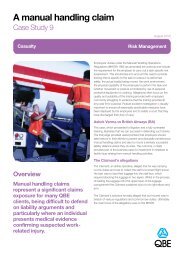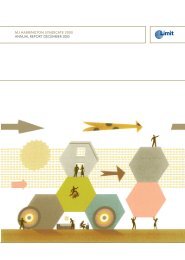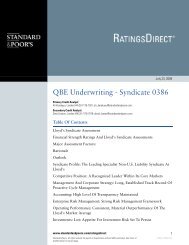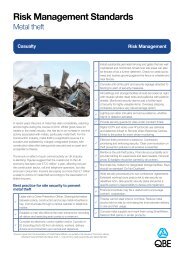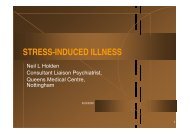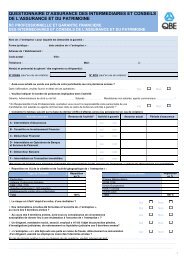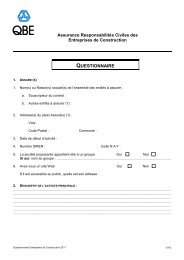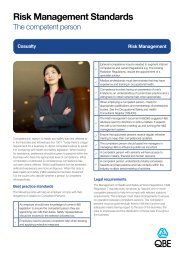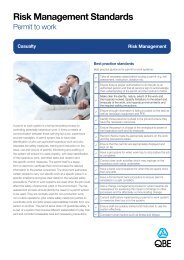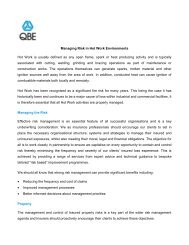Working at Height.pdf - QBE
Working at Height.pdf - QBE
Working at Height.pdf - QBE
- No tags were found...
You also want an ePaper? Increase the reach of your titles
YUMPU automatically turns print PDFs into web optimized ePapers that Google loves.
Legal dutiesNotwithstanding employers and employeesduties under the Health and Safety <strong>at</strong> WorkAct and Management of Health and Safety<strong>at</strong> Work Regul<strong>at</strong>ions, in April 2005 specificWork <strong>at</strong> <strong>Height</strong> Regul<strong>at</strong>ions (WAH) wereintroduced. These consolid<strong>at</strong>ed elementsof the existing Workplace (Health, Safety &Welfare) Regul<strong>at</strong>ions, the Construction(Health, Safety and Welfare) Regul<strong>at</strong>ionsand Provision and Use of Work EquipmentRegul<strong>at</strong>ions (PUWER).A key part of the WAH Regul<strong>at</strong>ions wasthe removal of the two metre rule and itsreplacement with a requirement to assessrisks where "a person could fall a distanceliable to cause personal injury". This includesfalls from any height and also those fromground level in to hazards like trenches,lift shafts and manholes.The WAH regul<strong>at</strong>ions require bestmanagement practice. An organis<strong>at</strong>ionwill need to ensure their health and safetymanagement system:• Enables them to plan all work <strong>at</strong> height.• Applies the "hierarchy of controlmeasures" (see figure 1).In the context of legal liability the WAHregul<strong>at</strong>ions impose an absolute duty tomanage the risk by consistent use of theword "shall" with regard to aspects suchas planning, competence and supervision."Reasonably practicable" only appears inrel<strong>at</strong>ion to the fact th<strong>at</strong> work <strong>at</strong> height mustbe "carried out in a manner which is so faras is reasonably practicable safe".Dutyholders must:avoid work <strong>at</strong> heightwhere they can;use work equipment or othermeasures to prevent falls where theycannot avoid working <strong>at</strong> height; andwhere they cannot elimin<strong>at</strong>e the risk of a fall, use workequipment or other measures to minimise the distanceand consequences of a fall should one occur.Figure 1, “Hierarchy of Control Measures”to consider during an assessment.To potentially defend a fall from height claim,it is necessary to critically examine whetherit was not reasonably practicable to applya better control measure in line with thehierarchy of control.• Selects the right people and equipmentfor the task.• Trains persons doing the work.• Inspects and maintains the equipmentused.• Ensures supervision and monitoring ofwork as per method st<strong>at</strong>ements, workinstructions and tool box talks.
Avoidance of work<strong>at</strong> height• Identify innov<strong>at</strong>ive solutions <strong>at</strong> the planning and designstage to avoid work <strong>at</strong> height e.g. manufacture beams th<strong>at</strong>allow edge protection to be installed <strong>at</strong> ground level beforethey are lifted in to place.• Use forklifts and cranes to unload vehicles.• Shrink wrap pallets/vehicle loads <strong>at</strong> ground level r<strong>at</strong>her thanmanual sheeting on vehicle.Prevention of falls • Identify and utilise an existing safe place of work <strong>at</strong> heightbefore considering additional equipment.• Make safe existing structures with suitably adequ<strong>at</strong>e edgeprotection i.e. guard rails <strong>at</strong> least 950mm above the edge, fittoebaords and intermedi<strong>at</strong>e guard rail so no gap is gre<strong>at</strong>erthan 470mm.• Design edge protection to cre<strong>at</strong>e permanent barrier e.g. rollover barriers when lifting goods onto mezzanine areas.• Work from mobile elev<strong>at</strong>ed working pl<strong>at</strong>forms such ascherry pickers or scissor lifts or use podium steps or towerscaffolds. (<strong>Working</strong> from ladders should be seen as a lastresort).Practical control measuresConsidering the hierarchy principles,consider<strong>at</strong>ion should be given to commonrisks encountered within the constructionindustry together with appropri<strong>at</strong>e controlmethodologies. This list is not exhaustiveand specific controls will need to beidentified as part of your risk assessment.Minimise consequenceof fallOther measures whenprevention andmitig<strong>at</strong>ion of falls is notreasonably practicable.• Ensure scaffolds are designed and erected in accordancewith TG20:08• Maintain high housekeeping standards.• Introduce protective equipment to reduce the distance andconsequences of a fall.• Use collective protection to protect all workers in preferenceto personal protective equipment. e.g. netting and crashm<strong>at</strong>s in preference to fall arrest lanyards.• Inspect and maintain personal and collective protectiveequipment.• Training and toolbox talks e.g. ladders, tower scaffolderection, use of mobile elev<strong>at</strong>ed working pl<strong>at</strong>forms.• Warning notices e.g. for fragile roofs.• Making edges highly visible when physical edge protectionis not practicable.• Foot and hand holds to aid secure vehicle access andegress.• Suitable emergency rescue procedures for a suspendedperson.3<strong>Working</strong> <strong>at</strong> height – construction sector – Aug 2009
Ladders and step laddersLadders, step ladders and other equipmentsuch as trestles neither prevent nor mitig<strong>at</strong>ethe consequence of a fall. Accidents fromsuch equipment could expose you toalleg<strong>at</strong>ions of failing to properly considerthe hierarchy of control measures. In theevent of an accident, you may need todemonstr<strong>at</strong>e why it was not reasonablypracticable to have avoided the taskaltogether or why more appropri<strong>at</strong>eequipment was not used. For examplecherry pickers, tower scaffolds, pl<strong>at</strong>formsteps with guard rails etc.Guidance within HSE INDG402, "Safe Useof Ladders and Stepladders" st<strong>at</strong>es th<strong>at</strong> aladder or stepladder should only be used:• In one position for maximum of30 minutes.• For light work (carrying less than 10kg).• Where a handhold is available.• Where you can maintain 3 points ofcontact with the ladder.Whilst this is sensible guidance for laddersused for simple tasks of short dur<strong>at</strong>ion, <strong>QBE</strong>would recommend you exercise caution onroutinely applying the 30 minute and 10kgguidance. All ladder work should be subjectto a risk assessment as the hierarchy ofcontrol within the regul<strong>at</strong>ions will takeprecedence over this guidance in a legalliability context.Where it has been determined th<strong>at</strong> laddersand stepladders are the most appropri<strong>at</strong>eequipment for the task you should ensureusers are provided with training, and th<strong>at</strong>safe working procedures are established,communic<strong>at</strong>ed, and employees’understanding valid<strong>at</strong>ed and documented.As a minimum HSE INDG405, "Top tips forladder and stepladder safety" st<strong>at</strong>es:• Inspect ladder before use.• Secure ladder and ensure it cannot slip.• Ground should be firm and level.• Ensure ladder angle of 75 degrees(1 unit out for every 4 units up).• Maintain 3 points of contact.• Do not work from the top 3 rungs.• Ensure ladder extends 3 rungs or1 metre above the place of landingto which it provides access.• Do not use step ladders side on.
Case studies – accidentexamplesUnsecured ladderA construction worker fell 2.3 m from aladder whilst accessing a scaffold. Theladder was not secured or footed and theworker was carrying an unreasonable loadfor the task. The construction company hadnot assessed m<strong>at</strong>erial handling on thescaffold and had not produced a methodst<strong>at</strong>ement. The injured man had received nohealth and safety induction when he arrivedon the site. The resultant claim wassuccessful.Unprotected loading rampAn oper<strong>at</strong>ive fell off the loading ramp, whilstbeing given instruction on the use of a palmcomputer to download d<strong>at</strong>a from anexcav<strong>at</strong>or. He was standing on the rampalongside the machine when he steppedbackwards and fell to the ground. He wasescorted to the canteen and then to hospitalwhere a subsequent medical examin<strong>at</strong>ionconfirmed he had suffered a fractured hip.The accident highlighted th<strong>at</strong> significantinjuries can be sustained from low level fallsand th<strong>at</strong> controls to protect such edges orraise awareness of them is required.Hazardous conditions andinadequ<strong>at</strong>e design ofscaffoldingA scaffolder aged 33 was working <strong>at</strong> aheight of 30 feet during strong winds whenthe scaffold collapsed. He was wearing aharness and was <strong>at</strong>tached to the scaffold.He sustained multiple fractures to both legsand hips together with head and neckinjuries and is unlikely to return to work in amanual capacity. The accident highlightedpoor working practices and procedurestogether with poor communic<strong>at</strong>ion anda lack of supervision.Scaffolding company ownerjailedA scaffolding company owner was jailed forbreach of a prohibition notice to ensure hismen were trained and competent to erectscaffold and work <strong>at</strong> height safely. He hada scaffold collapse, resulting in prosecution,a custodial sentence and a significant claim.5<strong>Working</strong> <strong>at</strong> height – construction sector – Aug 2009
ConclusionHSE st<strong>at</strong>istics show th<strong>at</strong> falls from height arethe main cause of workplace f<strong>at</strong>alities. TheWork <strong>at</strong> <strong>Height</strong> Regul<strong>at</strong>ions require all work<strong>at</strong> height, where a person could fall adistance liable to cause personal injury,to be assessed.With a clear hierarchy of control measuresand need for effective managementprocedures within the regul<strong>at</strong>ions, <strong>QBE</strong>recommends all policyholders formul<strong>at</strong>estr<strong>at</strong>egies to identify all tasks where work<strong>at</strong> height is required, seeking to avoid suchwork wherever possible or introduceequipment or procedures th<strong>at</strong> prevent fallsand/or minimise the consequences of falls.
References/useful inform<strong>at</strong>ionPublic<strong>at</strong>ionIND(G) 401 <strong>Working</strong> <strong>at</strong> height a “brief guide”Work <strong>at</strong> <strong>Height</strong> Solutions D<strong>at</strong>abaseIND(G) 402 Safe use of ladders and stepladdersIND(G) 405 Top tips for ladders and stepladders safetyIND(G) 395 Avoiding falls from vehiclesIND(G) 367 Inspecting fall arrest equipmentHSC Falls from height St<strong>at</strong>isticsHSE <strong>Working</strong> on RoofsNASC SG4:05 Preventing Falls in Scaffolding and FalseworkNASC TG20:08 Scaffolding with Tubes and FittingsDownload/further inform<strong>at</strong>ionwww.hse.gov.uk/pubns/indg401.<strong>pdf</strong>www.hse.gov.uk/falls/solutions.htmwww.hse.gov.uk/pubns/indg402.<strong>pdf</strong>www.hse.gov.uk/pubns/indg405.<strong>pdf</strong>www.hse.gov.uk/pubns/indg395.<strong>pdf</strong>www.hse.gov.uk/pubns/indg367.<strong>pdf</strong>www.hse.gov.uk/st<strong>at</strong>istics/<strong>pdf</strong>/rhsfall.<strong>pdf</strong>www.hse.gov.uk/sh<strong>at</strong>teredlives/workingonroofs.<strong>pdf</strong>www.nasc.org.uk/index.shtmlwww.nasc.org.uk/index.shtmlYou can find further inform<strong>at</strong>ion <strong>at</strong>www.<strong>QBE</strong>europe.com/rm oremail rm@uk.qbe.com7<strong>Working</strong> <strong>at</strong> height – construction sector – Aug 2009
Author BiographyJon Lawrence, Risk Manager.Jon Lawrence joined <strong>QBE</strong> in 2001 andhas over 20 years experience within theinsurance industry primarily in the field ofliability risk management. Jon specialises inhealth and safety management systems andassists clients to reduce their risk exposuresand to mitig<strong>at</strong>e potential losses. Jon takes akeen interest in the area of slips, trips andfalls and has contributed to public<strong>at</strong>ionsand represents the insurance industry onHSE stakeholder groups.Jon is a Chartered Safety and HealthPractitioner and member of IOSH.DisclaimerThis Forum has been produced by<strong>QBE</strong> Insurance (Europe) Limited (“QIEL”).QIEL is a company member of the<strong>QBE</strong> Insurance Group.Readership of this Forum does not cre<strong>at</strong>ean insurer-client, advisor-client, or otherbusiness or legal rel<strong>at</strong>ionship.This Forum provides inform<strong>at</strong>ion about thelaw to help you understand and manage riskwithin your organis<strong>at</strong>ion. Legal inform<strong>at</strong>ionis not the same as legal advice. This Forumdoes not purport to provide a definitivest<strong>at</strong>ement of the law and is not intendedto replace, nor may it be relied upon asa substitute for specific legal or otherprofessional advice.QIEL has acted in good faith to provide anaccur<strong>at</strong>e Forum. However, QIEL and the<strong>QBE</strong> Group do not make any warrantiesor represent<strong>at</strong>ions of any kind about thecontents of this Forum, the accuracy ortimeliness of its contents, or th<strong>at</strong> theinform<strong>at</strong>ion or explan<strong>at</strong>ions (if any) given.QIEL and the <strong>QBE</strong> Group do not haveany duty to you, whether in contract, tort,under st<strong>at</strong>ute or otherwise with respectto or in connection with this Forum orthe inform<strong>at</strong>ion contained within it.QIEL and the <strong>QBE</strong> Group have nooblig<strong>at</strong>ion to upd<strong>at</strong>e this report orany inform<strong>at</strong>ion contained within it.To the fullest extent permitted by law,QIEL and the <strong>QBE</strong> Group disclaim anyresponsibility or liability for any loss ordamage suffered or cost incurred by youor by any other person arising out of or inconnection with your or any other person’sreliance on this Report or on the inform<strong>at</strong>ioncontained within it and for any omissionsor inaccuracies.<strong>QBE</strong> Insurance (Europe) Limited and<strong>QBE</strong> Underwriting Limited are authorisedand regul<strong>at</strong>ed by the Financial ServicesAuthority. <strong>QBE</strong> Management Services (UK)Limited and <strong>QBE</strong> Underwriting Services (UK)Limited are both Appointed Represent<strong>at</strong>ivesof <strong>QBE</strong> Insurance (Europe) Limited and<strong>QBE</strong> Underwriting Limited.
<strong>QBE</strong> European Oper<strong>at</strong>ionsPlant<strong>at</strong>ion Place30 Fenchurch StreetLondonEC3M 3BDtel +44 (0)20 7105 4000fax +44 (0)20 7105 4019differently@uk.qbe.comwww.<strong>QBE</strong>europe.com1159/ISSUESFORUM/WORKATHEIGHT/AUG09<strong>QBE</strong> European Oper<strong>at</strong>ions is a trading name of <strong>QBE</strong> Insurance (Europe) Limited and <strong>QBE</strong> Underwriting Limited. <strong>QBE</strong> Insurance (Europe) Limitedand <strong>QBE</strong> Underwriting Limited are authorised and regul<strong>at</strong>ed by the Financial Services Authority. <strong>QBE</strong> Management Services (UK) Limited and<strong>QBE</strong> Underwriting Services (UK) Limited are both Appointed Represent<strong>at</strong>ives of <strong>QBE</strong> Insurance (Europe) Limited and <strong>QBE</strong> Underwriting Limited.



